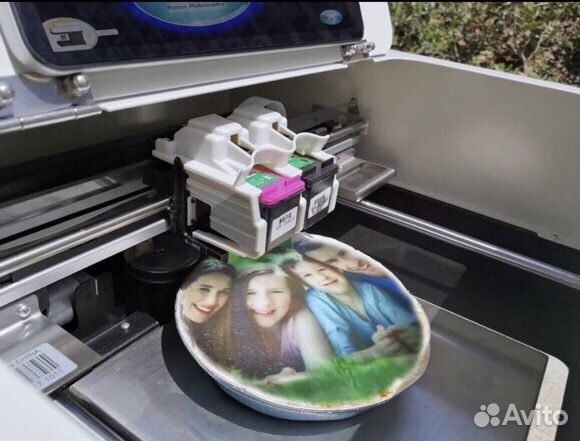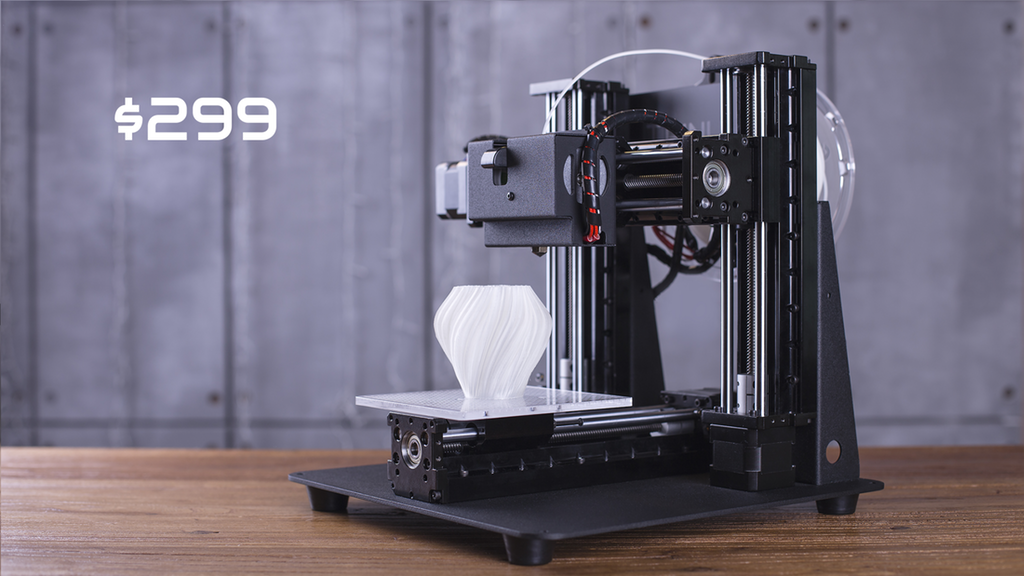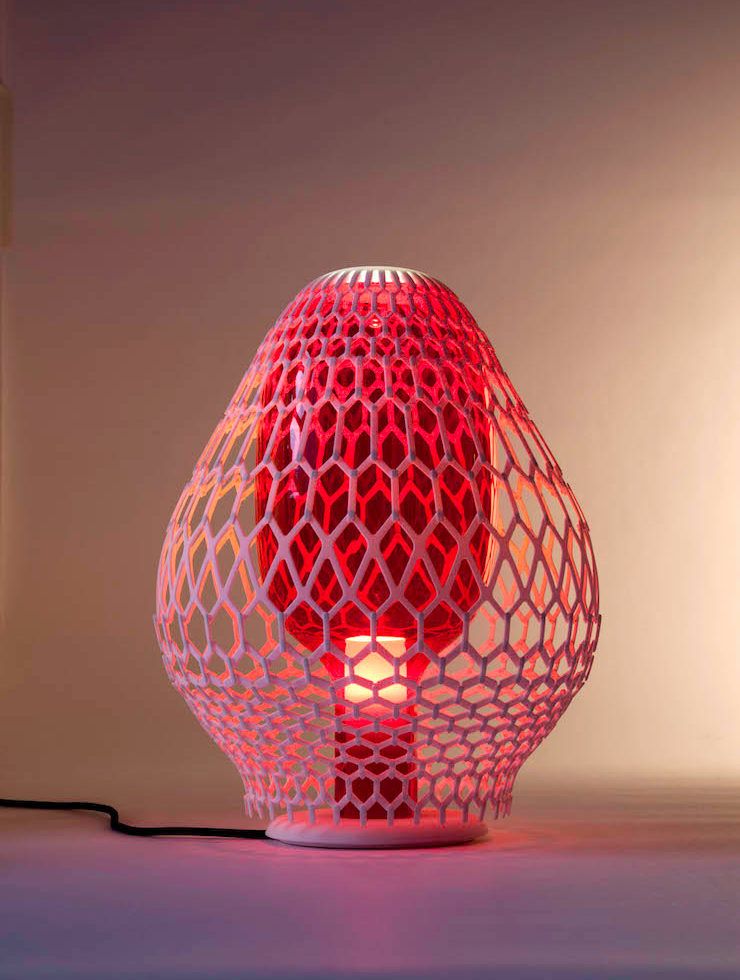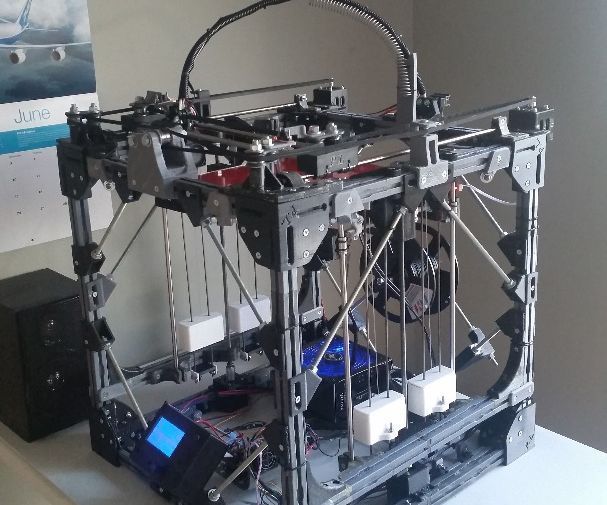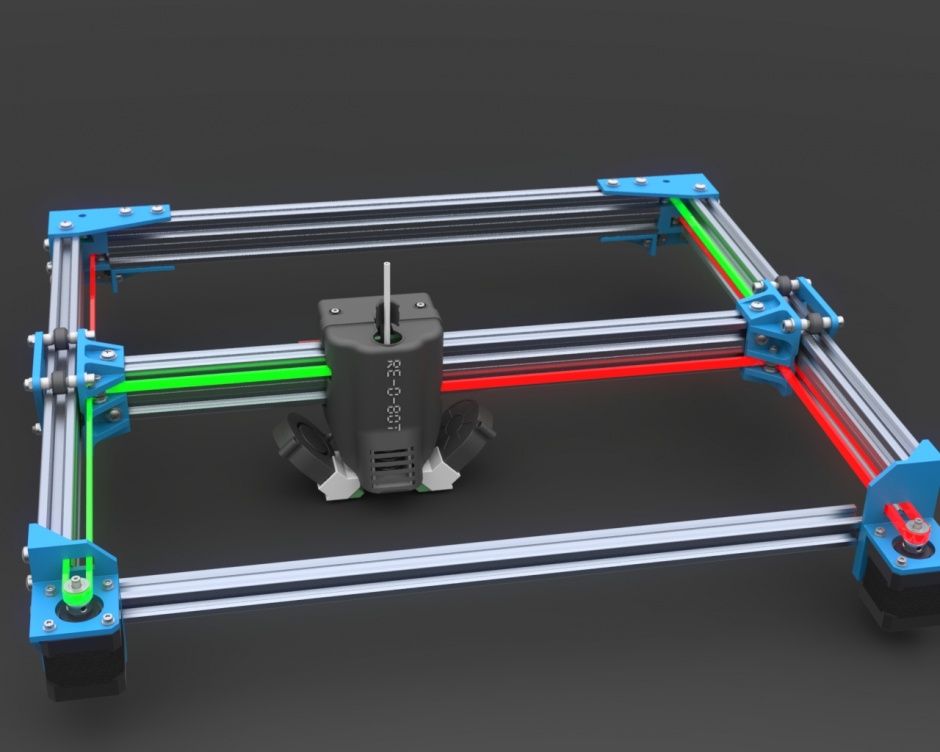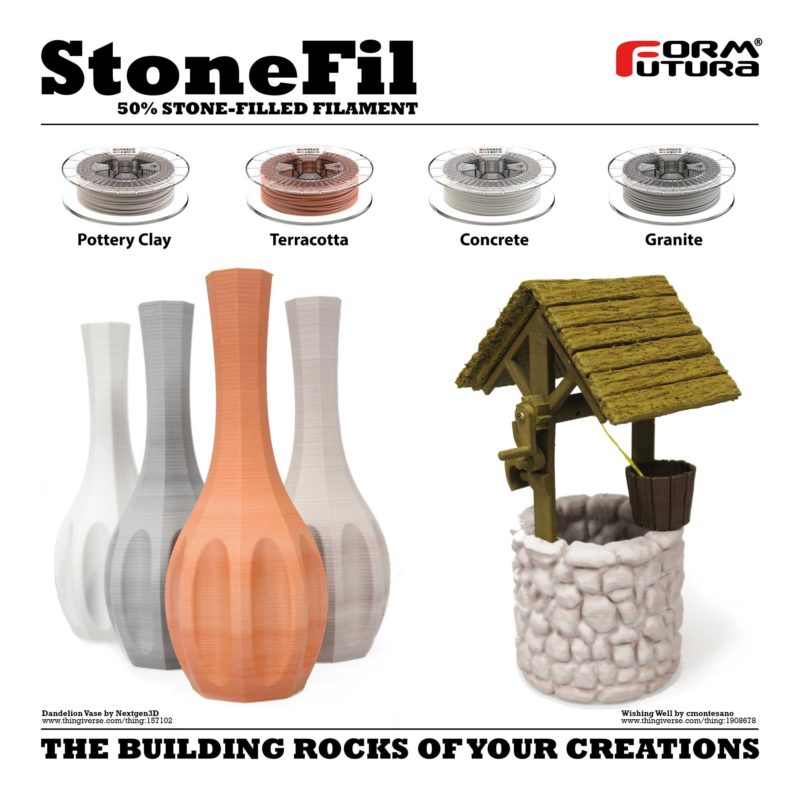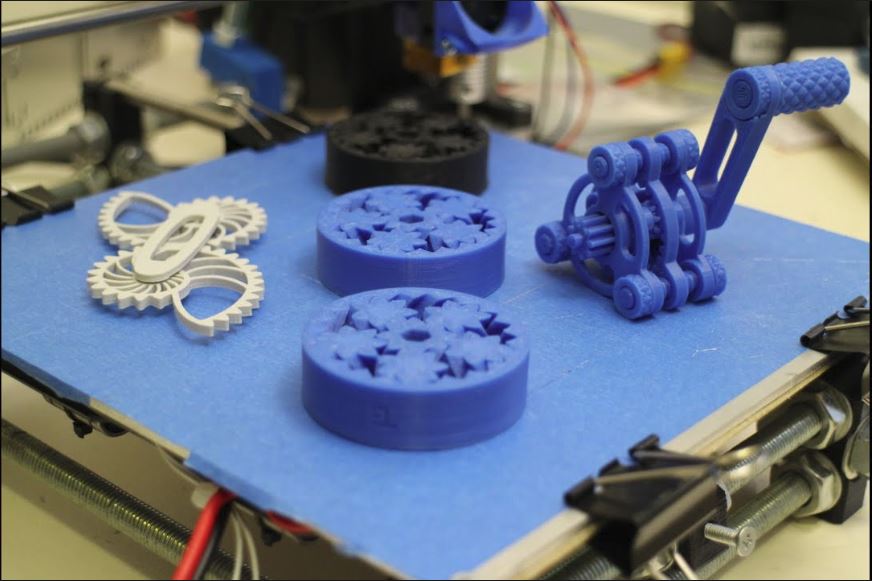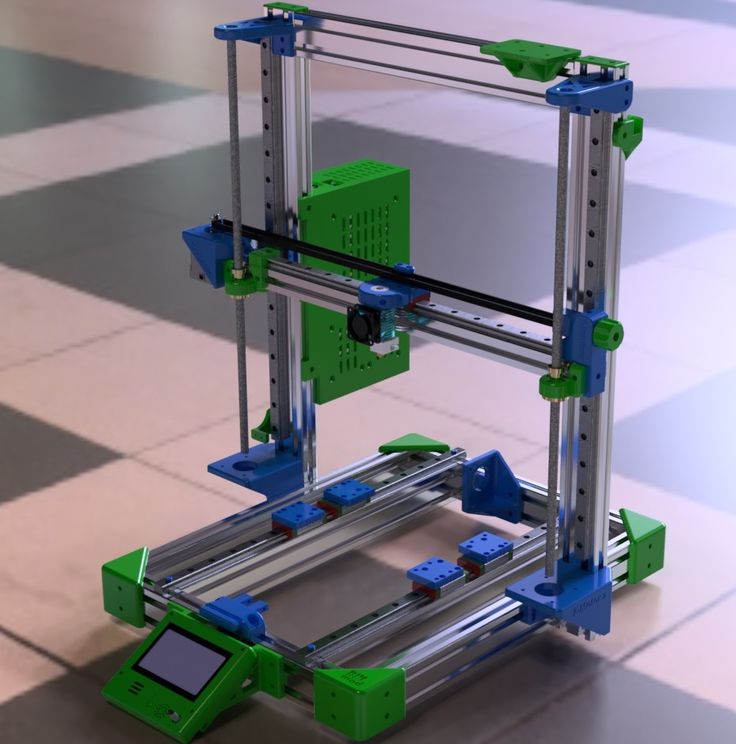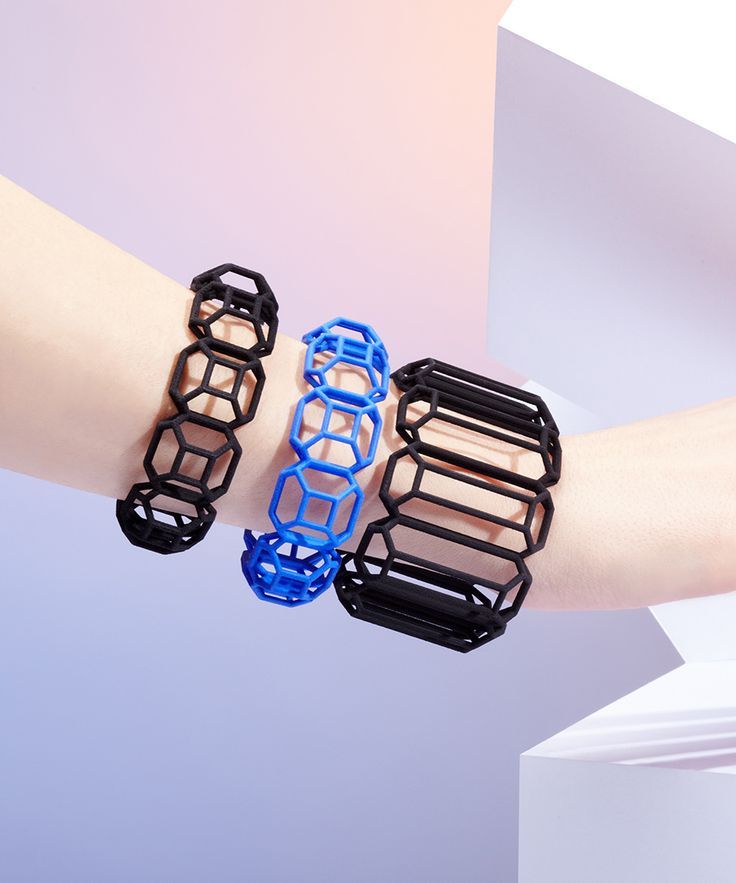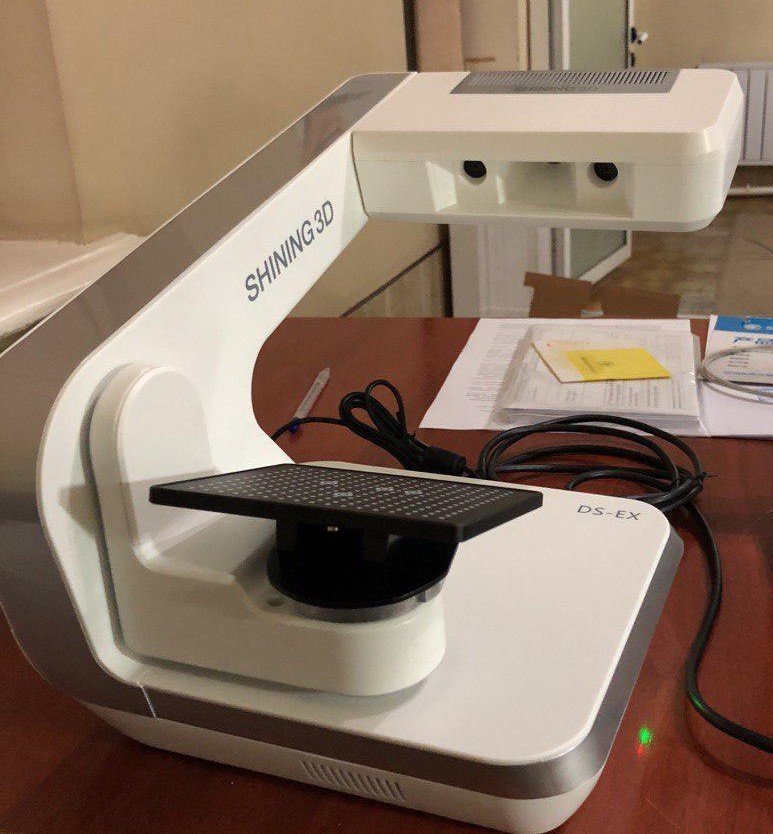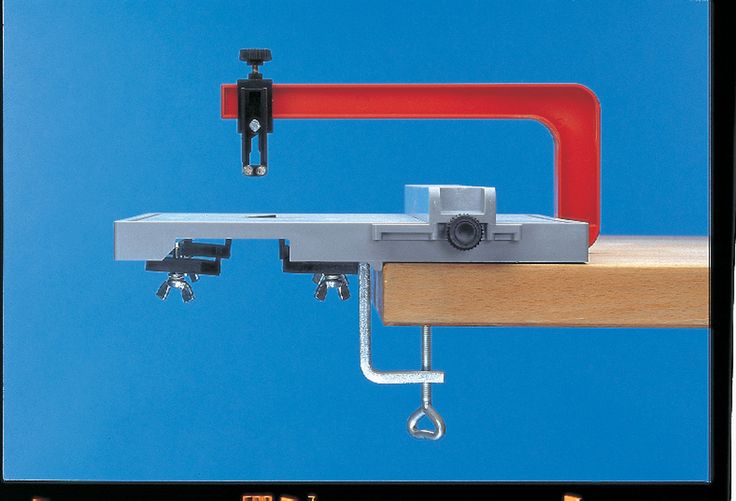3D printer prints food
The Ten Food 3D Printers You Should Know
Published on December 16, 2021 by Madeleine P.
3D printing materials are becoming increasingly diverse, but when we talk about additive manufacturing, we often think of plastics or metals. But today, we wanted to focus on something very different namely food. And yes, some 3D printers do allow for the creation of sweets, pastries, chocolates, pizzas and dishes of all kinds. A food 3D printer offers more freedom and creativity in the kitchen and in some cases, can even reduce food waste. Even if we are not yet convinced that these machines will replace our ovens and microwaves, they have an interesting potential for all those who love to cook. In this listing, we introduce you to food 3D printers that are already being used!
3D Chocolate Shaper – byFlow
Food Tech company byFlow specializes in 3D printing of chocolate. To print with the notoriously tricky ingredient, the company has developed 3D Chocolate Shaper, based on a patented technology to design all types of chocolate parts. ByFlow provides you with the Online Chocolate Design Studio, where you can create your own chocolate designs in minutes. Any type of chocolate can be used with a fully automatic temperature control system. Note that you can also use this 3D printer to design other sweet or savory foods. ByFlow also opened one of the first restaurants to integrate a 3D food printer.
Photo Credits: byFlow
WiibooxSweetin
The WiibooxSweetin food 3D printer is a printer that combines precision, quality and creativity and is designed for professional use. Additionally, the machine is easy to use. All users need to do is download the 3D model files into the machine and start printing. The printing materials? There’s (really) something for everyone: chocolate, cheese, mashed potatoes, beans, caramel, honey, jam, cookies. The printer includes a real-time temperature control device that ensures food is perfectly sealed. The technology used is fused deposition modeling (FDM), has several types of nozzles included and is compatible with . stl .obj . amr files.
stl .obj . amr files.
Photo Credits: WiibooxSweetin
SMRC’s 3D Printing System for Space
When people think of 3D printed food, most of the time it is for projects for people on Earth. But this is not always the case. Enter SMRC’s 3D printed food system which has been developed to make food for long duration space missions in collaboration with NASA. The company aims to create food using 3D printing that has interesting flavors while including nutrient supplements that will set off nutritional degradation from long-term storage. Essentially, the system will dispense viscous food that has been made from powder and ingredients and they have already successfully made cheese pizza using it. They hope to provide healthy nutrition for astronauts.
nūfood from Dovetailed
nūfood, which was born from a hackathon, is the world’s first liquid-based 3D food printer and was created by Dovetailed.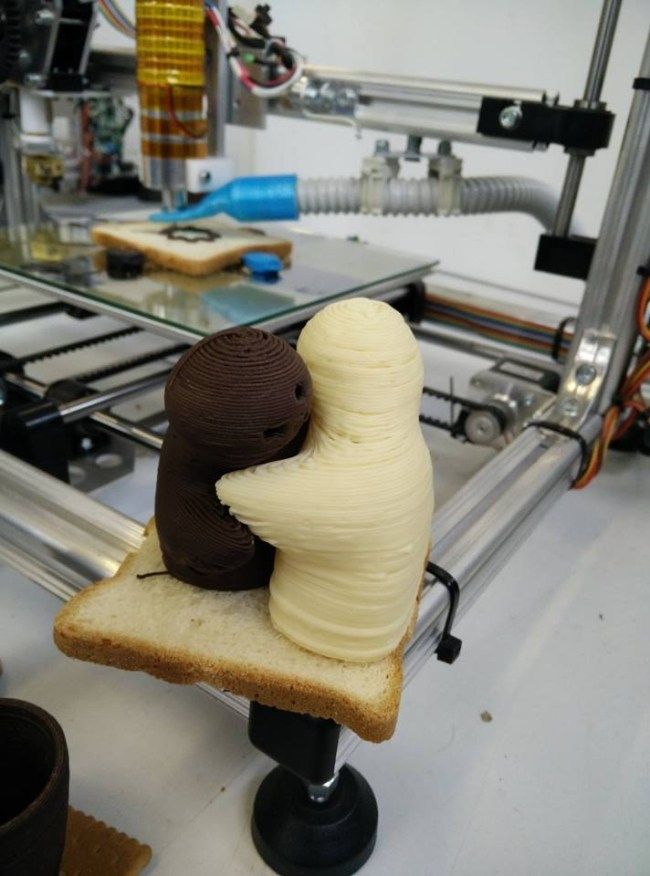 The company is tight-lipped on how exactly the 3D printing technology works, but the result is essentially edible, 3D printed flavor bubbles as the printer “offers the ability to create juicy bites in a variety of shapes, flavors and colors on-demand.” Users can just tap the available app, pour in the flavors and then print, with 3D food flavor bursts ready in minutes. Additionally, the ingredients are high-quality and vegan-friendly ranging from both savory to sweet. The printer is available to rent in the United Kingdom for events on their website, though they also note that it is ready for commercial manufacture.
The company is tight-lipped on how exactly the 3D printing technology works, but the result is essentially edible, 3D printed flavor bubbles as the printer “offers the ability to create juicy bites in a variety of shapes, flavors and colors on-demand.” Users can just tap the available app, pour in the flavors and then print, with 3D food flavor bursts ready in minutes. Additionally, the ingredients are high-quality and vegan-friendly ranging from both savory to sweet. The printer is available to rent in the United Kingdom for events on their website, though they also note that it is ready for commercial manufacture.
Photo Credits: Dovetailed
mycusini® 2.0
This chocolate 3D printer definitely steals the show from other kitchen appliances! The mycusini® 2.0 has been enhanced with interesting features since its predecessor and represents the latest generation of the machine. The first thing that catches the eye is the timeless design combined with pink elements. But the device is not only visually a real eye-catcher: the mycusini® 2.0 has an integrated library of over 1,000 objects that can be called up with the 3.5″ touch color display, including object preview. If you want to design your 3D objects yourself, you get free access to the mycusini Club. Objects can be printed with the provided Choco Refills with a size of up to 90 x 90mm. The removable platform allows easy cleaning of the device. The device is available at a special price of €758.70 on the manufacturer’s website.
But the device is not only visually a real eye-catcher: the mycusini® 2.0 has an integrated library of over 1,000 objects that can be called up with the 3.5″ touch color display, including object preview. If you want to design your 3D objects yourself, you get free access to the mycusini Club. Objects can be printed with the provided Choco Refills with a size of up to 90 x 90mm. The removable platform allows easy cleaning of the device. The device is available at a special price of €758.70 on the manufacturer’s website.
Photo Credits: mycusini
Choc Creator V2.0 Plus
After the success of the Choc Creator V1 and V2 devices (which are no longer sold), the Choc Creator V2.0 Plus is the optimized version of the Choc Edge chocolate 3D printer. The device scores with a larger design area of 180 mm x 180 mm x 40 mm and allows the production of creative chocolate creations with fine lines from 0.8 mm width. Common STL files can be used, which are transferred directly to the device with a USB stick. Two 0.8 mm metal nozzles are included and the machine comes with pre-installed ready-to-print 2D and 3D G-codes, making the Choc Creator V2.0 Plus ready for immediate use. The machine can be purchased for around €3,350.
Two 0.8 mm metal nozzles are included and the machine comes with pre-installed ready-to-print 2D and 3D G-codes, making the Choc Creator V2.0 Plus ready for immediate use. The machine can be purchased for around €3,350.
Photo Credits: Choc Edge
Foodini, the 3D food printer par excellence
Foodini is surely one of the most popular 3D food printers today. It is a kitchen appliance developed by the company Natural Machines, which allows food customization and 3D printing. They claim that this solution allows eating healthier dishes, improving kitchen efficiency and reducing food waste. The competitive advantage is that users can create all kinds of dishes using their own natural and fresh ingredients. In terms of user experience, the Foodini stands out for its ease of setup and interaction when working with the machine. From loading the stainless steel capsules to interacting with the large touch screen, Foodini guides the user through every step of the process. What better way to get started in food 3D printing?
Photo Credits: Natural Machines
Brill 3D Culinary Studio, 3D printing in the culinary arts
Brill Inc.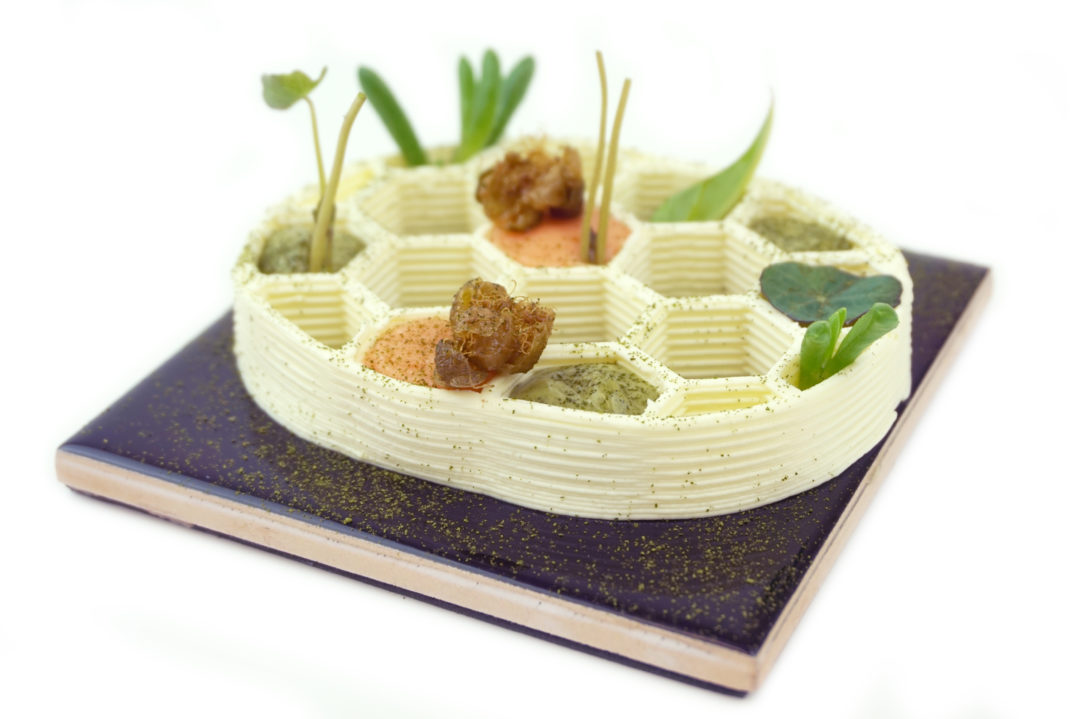 and 3D Systems have teamed up to develop an innovative new additive manufacturing system that aims to revolutionize the culinary arts. The result of a multi-year collaboration, this professional, full-color 3D printing technology offers culinary enthusiasts a unique opportunity to create original, customized dishes, figures, garnishes and anything else they can imagine. As for the 3D printing process, users must begin by separating the wet and dry ingredients, so that the machine can mix them with automated precision, and then create the models layer by layer. This system includes 3D Systems’ software, the Brill 3D Culinary Printer machine and finally the powders and binders that allow the production of an unlimited range of original creations.
and 3D Systems have teamed up to develop an innovative new additive manufacturing system that aims to revolutionize the culinary arts. The result of a multi-year collaboration, this professional, full-color 3D printing technology offers culinary enthusiasts a unique opportunity to create original, customized dishes, figures, garnishes and anything else they can imagine. As for the 3D printing process, users must begin by separating the wet and dry ingredients, so that the machine can mix them with automated precision, and then create the models layer by layer. This system includes 3D Systems’ software, the Brill 3D Culinary Printer machine and finally the powders and binders that allow the production of an unlimited range of original creations.
Photo Credits: Brill Inc
Procusini 5.0
The Procusini 5.0 food 3D printer was developed by the German company Print2Taste and is based on an extrusion process. It has a printing plate of 25 x 15 cm and weighs only 9 kilos making it easy to transport and integrate into the kitchen. It is considered today as a machine for the professionals of the restoration. It offers automatic calibration and connectivity via an SD card. It is a printer that has cartridges that can be heated up to 60 degrees, easily cleaned and simple to change. The Procusini 5.0 user will be able to access the Procusini Club allowing him to download more than 1,000 templates, logos, messages, etc. as well as to get tips and tricks.
It is considered today as a machine for the professionals of the restoration. It offers automatic calibration and connectivity via an SD card. It is a printer that has cartridges that can be heated up to 60 degrees, easily cleaned and simple to change. The Procusini 5.0 user will be able to access the Procusini Club allowing him to download more than 1,000 templates, logos, messages, etc. as well as to get tips and tricks.
Photo Credits: Print2Taste
The Mmuse food 3D printer
Chinese manufacturer Mmuse is behind the eponymous machine, which specializes in chocolate extrusion. It is a food 3D printer that has a printing volume of 160 x 130 x 150 mm, a nozzle of 0.8 mm in diameter and a printing speed of 30-60 mm / s. The Mmuse printer uses cocoa beans that it melts, all in a controlled environment in terms of temperature. It also incorporates a touch screen to facilitate the operations of the user and monitor in real time its prints. Today, this food 3D printer is available from 5 700 dollars.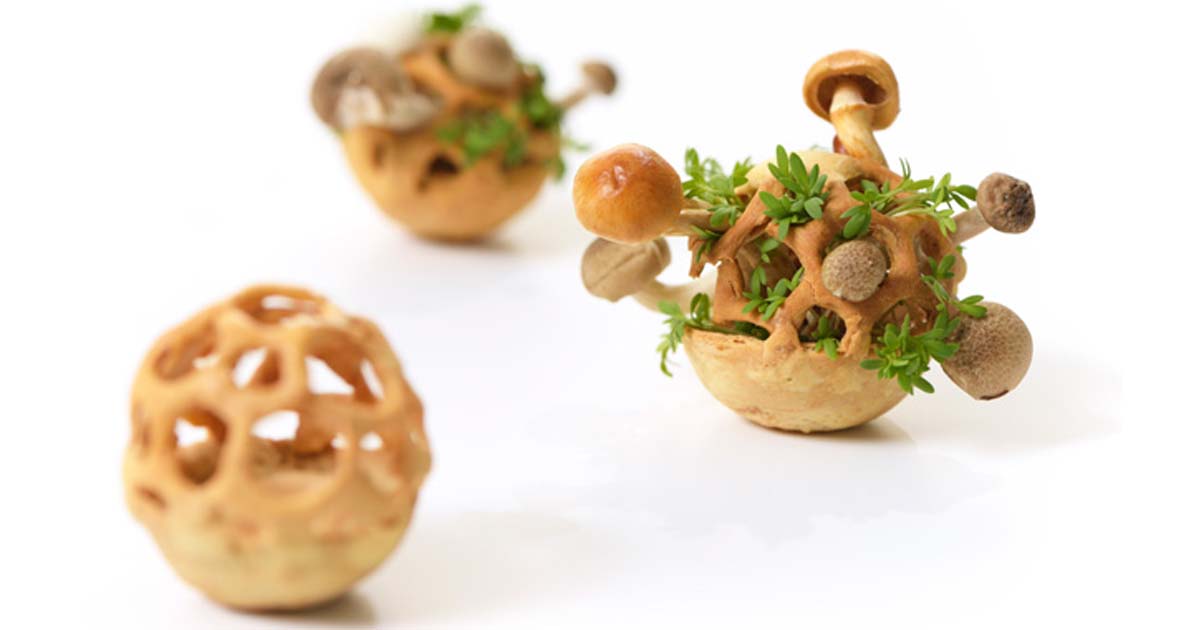
What do you think of our list of food 3D printers? Let us know in a comment below or on our Linkedin, Facebook, and Twitter pages! Don’t forget to sign up for our free weekly Newsletter here, the latest 3D printing news straight to your inbox! You can also find all our videos on our YouTube channel.
Top food 3D printers available this year
What is food 3D printing?
Although it may sound like something from a sci-fi movie, food 3D printers do actually exist. Edible 3D printing is becoming more and more popular not only for professionals but also for personal use. That said, how does food 3D printing work? To what extent is it similar to standard 3D printing?
Most food 3D printers use extrusion 3D printing technology, much like regular desktop FFF (FDM) 3D printers. Instead of using plastic material, though, food 3D printers use paste-type ingredients. The most common ingredients are chocolate, pancake batter, and cream, although there are many other possibilities (even pizza!). They are 3D printed layer after layer, generally through a syringe-like extruder.
Instead of using plastic material, though, food 3D printers use paste-type ingredients. The most common ingredients are chocolate, pancake batter, and cream, although there are many other possibilities (even pizza!). They are 3D printed layer after layer, generally through a syringe-like extruder.
To get a better overview of this niche, we have put together a comprehensive list of food 3D printers on the market. This selection is based on available food 3D printers under $6,000. We also mention a few other food customization solutions, including coffee 3D printing, food ornament 3D printing, and 3D printing food molds.
Bon appétit!
Best food 3D printers available on the market
| Brand | Product | Build size | Country | Price Approximate starting prices based on supplier-provided information and public data. Prices may vary by region, over time and do not include additional products or services (taxes, shipping, accessories, training, installation, …). | |
|---|---|---|---|---|---|
| Micromake | Food 3D printer | 100 × 100 × 15 mm3.94 × 3.94 × 0.59 in | – | $ 9991 015 €886 £148,907 ¥ | Contact |
| Choc Edge | Choc Creator V2.0 Plus | 180 × 180 × 40 mm7.09 × 7.09 × 1.57 in | – | $ 2,6832 727 €2,380 £399,929 ¥ | Quote |
| ZMorph | VX | 250 × 235 × 165 mm9.84 × 9.25 × 6.5 in | – | $ 2,7992 845 €2,483 £417,208 ¥ | Quote |
| byFlow | Focus | 208 × 228 × 150 mm8.19 × 8.98 × 5.91 in | – | $ 3,6303 300 €3,220 £541,073 ¥ | Quote |
| Natural Machines | Foodini | 250 × 165 × 120 mm9.84 × 6.5 × 4.72 in | – | $ 4,0004 066 €3,548 £596,224 ¥ | Quote |
| Mmuse | Chocolate 3D printer | 160 × 120 × 150 mm6.3 × 4.72 × 5.91 in | – | $ 5,4995 590 €4,878 £819,659 ¥ | Quote |
Expand to see more specs
The products in the table are ranked by price (low to high).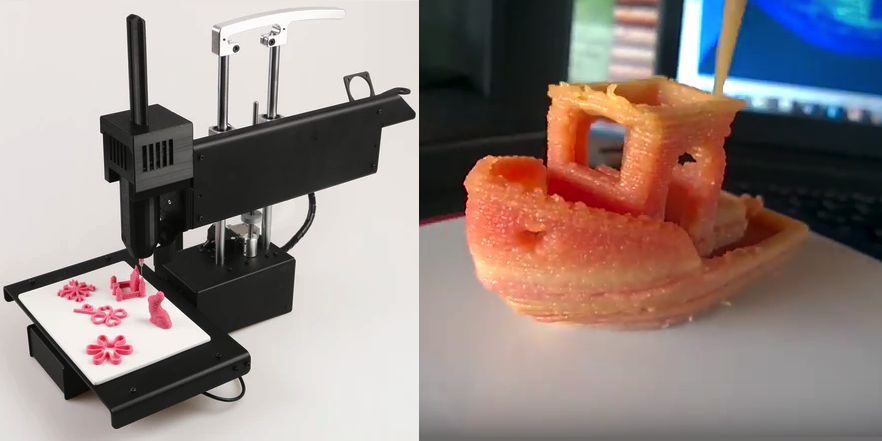
| Brand | Product | Build size | Country | Price Approximate starting prices based on supplier-provided information and public data. Prices may vary by region, over time and do not include additional products or services (taxes, shipping, accessories, training, installation, …). | |
|---|---|---|---|---|---|
| Micromake | Food 3D printer | 100 × 100 × 15 mm3.94 × 3.94 × 0.59 in | – | $ 9991 015 €886 £148,907 ¥ | Contact manufacturer |
| Choc Edge | Choc Creator V2.0 Plus | 180 × 180 × 40 mm7.09 × 7.09 × 1.57 in | – | $ 2,6832 727 €2,380 £399,929 ¥ | Get a quote |
| ZMorph | VX | 250 × 235 × 165 mm9.84 × 9.25 × 6.5 in | – | $ 2,7992 845 €2,483 £417,208 ¥ | Get a quote |
| byFlow | Focus | 208 × 228 × 150 mm8.19 × 8.98 × 5.91 in | – | $ 3,6303 300 €3,220 £541,073 ¥ | Get a quote |
| Natural Machines | Foodini | 250 × 165 × 120 mm9. 84 × 6.5 × 4.72 in 84 × 6.5 × 4.72 in | – | $ 4,0004 066 €3,548 £596,224 ¥ | Get a quote |
| Mmuse | Chocolate 3D printer | 160 × 120 × 150 mm6.3 × 4.72 × 5.91 in | – | $ 5,4995 590 €4,878 £819,659 ¥ | Get a quote |
Pros and cons of food 3D printing
Benefits of 3D printing food
Time-saving
Edible 3D printing can be less time-consuming than traditional cooking. Indeed, users can launch a food 3D print and move on to other activities. Once the food 3D print is launched, there is no more need for manual operation.
Customization
Food 3D printing enables users to customize their food according to special events or simply to their mood. It can vary from writing a name on a birthday cake to 3D printing a heart-shaped pancake, for instance.
Creativity
Edible 3D printing enables cooking aficionados to unleash even more creativity in the kitchen. Users can imagine and actually create intricate designs. Amazing 3D-printed food artwork already exists!
Users can imagine and actually create intricate designs. Amazing 3D-printed food artwork already exists!
Limits to food 3D printers
Type of food
Not just any sort of food can be 3D printed. The food must be in the form of a paste, such as cream or mashed potatoes.
Partial cookingThe 3D printing process doesn’t encompass every step of a meal’s preparation. For instance, food 3D printers cannot bake a cake or sprinkle oregano over a pizza.
Price
Food 3D printers are a bit expensive, generally in a price range between $1,000 and $5,000 (although there are exceptions).
Risk of failure
Just like with any other type of 3D printing, food 3D prints can be unsuccessful – too bad if it’s a birthday cake!
Food 3D printers: overview
The byFlow Focus is a compact food 3D printer made by byFlow, a Dutch 3D printing company specialized in edible 3D printing.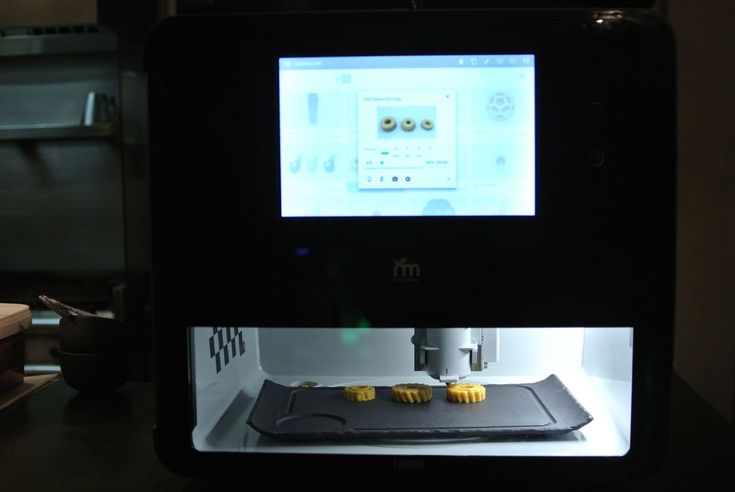 This food 3D printer targets mostly professionals in the bakery industry.
This food 3D printer targets mostly professionals in the bakery industry.
The Focus works with refillable cartridges containing any kind of paste-type food to create customized meals. Furthermore, users have the possibility to access downloadable recipes.
Contact manufacturer Get a quote Add to comparison
The Choc Edge Choc Creator is a chocolate 3D printer targeting mostly professionals in chocolate and confectionery industries.
In addition, Choc Edge develops three apps, CHOC DRAW, MIX & MATCH and CHOC TEXT, to help users to draw and write on their chocolate 3D prints. A slicing software, ChocPrint, is also available.
Contact manufacturer Get a quote Add to comparison
The Micromake Food 3D printer can 3D print all kinds of paste-type ingredients, such as tomato sauce, chocolate sauce, and salad sauce. Also, the removable heated build plate is able to bake ingredients such as pancake batter.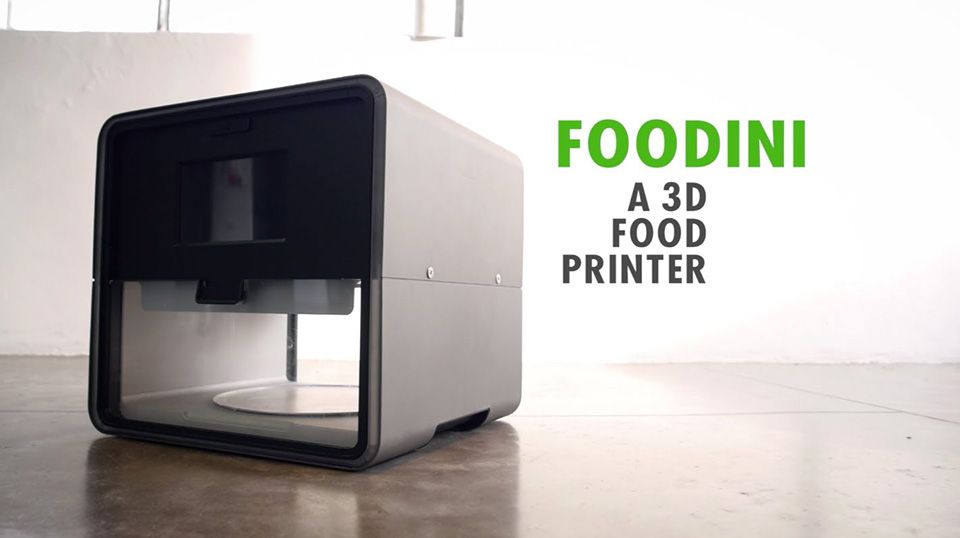
Contact manufacturer Add to comparison
The Mmuse Chocolate 3D printer is a closed-framed chocolate 3D printer made by Muse, a manufacturer from China. This 3D printer uses chocolate beans as consumables: they melt in the extruder, just as with regular FFF/FDM 3D printing.
Contact manufacturer Get a quote Add to comparison
The Natural Machines Foodini is a 3D printer able to 3D print all kinds of paste-type food. Users can fill the Foodini’s capsules with any type of paste food they wish.
Furthermore, if users choose a specific Foodini recipe, the 3D printer gives instructions on which ingredients to insert into the capsules.
Contact manufacturer Get a quote Add to comparison
Thanks to its thick-paste extruder, the ZMorph VX can 3D print ceramics as well as food!
This multifunctional 3D printer is indeed able 3D print with chocolate, cookie dough, cream cheese, frosting and more.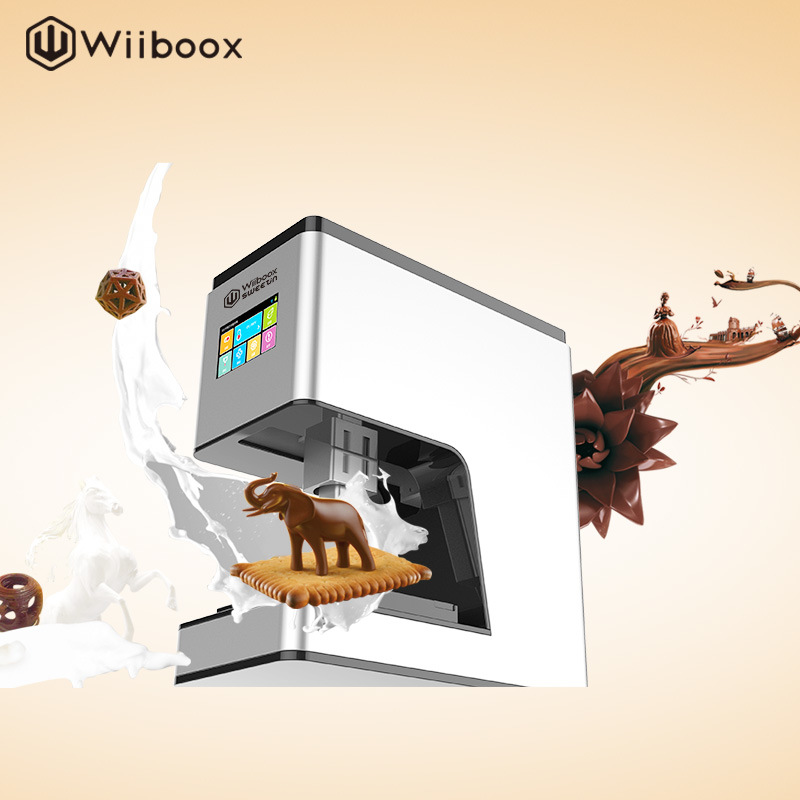
In addition to paste extrusion, the VX is features CNC milling and laser engraving capabilities.
Contact manufacturer Get a quote Add to comparison
Special mention: Cakewalk
- Materials: chocolate, meringue, royal icing, ketchup, guacamole, cream cheese, butter, mashed vegetables, Swiss butter cream
- Price:
- During KS campaign: €49 to €89
- After KS = €119
Cakewalk 3D is a precise and practical extruder that converts your desktop 3D printer into a food printer. The screw-in extruder is designed to be easily installed on any type of Cartesian 3D printer. All parts are food-safe and easily washable in your dishwasher.
To adapt Cakewalk 3D to your printer, you just need to 3D print 3 or 4 pieces of support in plastic. Disassembling your plastic extruder, screwing in the support parts, and connecting the motor to your card takes less than 30 min. The extruder then works with your usual slicer.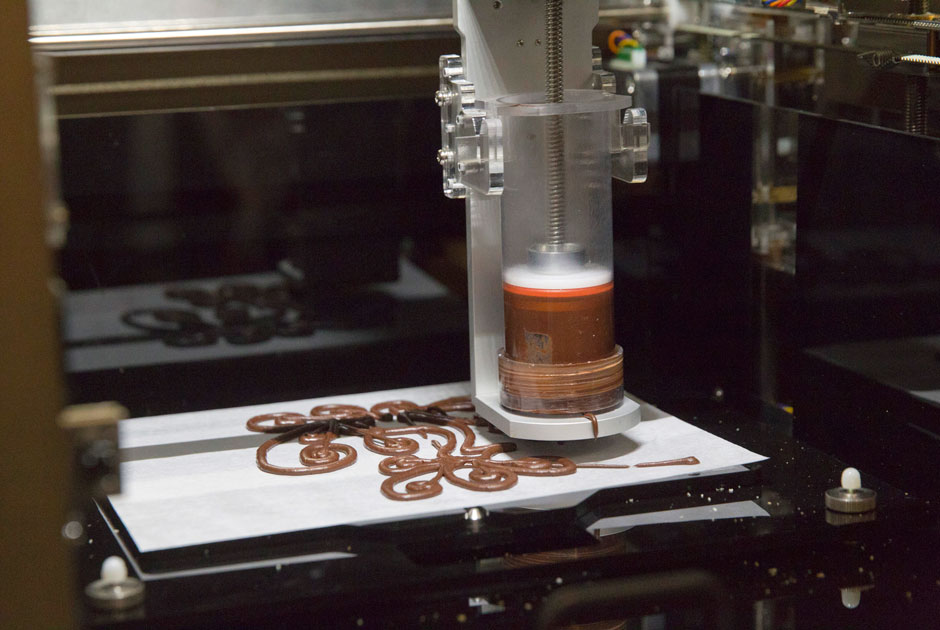
Cakewalk3D Kickstarter campaign
Edible 3D printing: who is it for?
Restaurants and bakeries
Edible 3D printing is indeed very useful for professionals in the food industry. 3D printed food can be attractive to new customers seeking different food experiences. A restaurant serving 3D-printed food, the Food Ink. pop-up store already exists.
Industrial food production
In the industrial food production sector, edible 3D printing allows manufacturers to vary their product ranges with new creations. Furthermore, food 3D printers can achieve a high level of precision. Barilla, an Italian food company, 3D prints some of its pasta products.
Food 3D printing at home
Food 3D printers are also adapted for personal use. They allow for more creativity in the kitchen with food customization.
What food can be 3D printed?
Ingredients
Virtually any type of fresh food can be 3D printed as long as it’s a paste, or “purée”.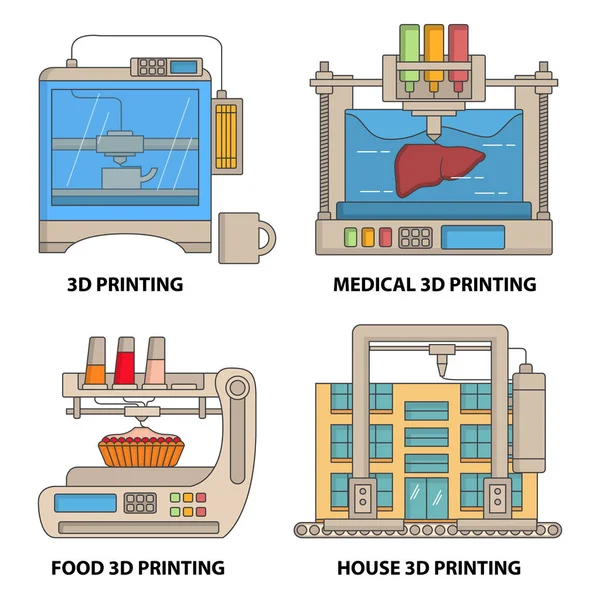 For instance, ingredients could be:
For instance, ingredients could be:
- Chocolate, candy and sugars
- Pancake batter or cookie dough
- Dairy products
- Pasta, wheats and grains
- Fruits and vegetables
Even pizza can be partly 3D printed! However, users will have to sprinkle their favorite toppings manually.
3D printed pizza by Beehex. Source: BeehexFood 3D models
To 3D print food, we can let our imagination take over. Users indeed have the opportunity to create their own food 3D models with special CAD software. However, it is also possible to directly download any 3D model on dedicated STL file websites.
How much does a food 3D printer cost?
Food 3D printer price
There are various price points for food 3D printers. Prices can depend on the food 3D printer’s build volume and/or on the variety of 3D printable ingredients it is compatible with.
In general, the minimum price for a food 3D printer is around $1,000 (although the PancakeBot is available for under $400).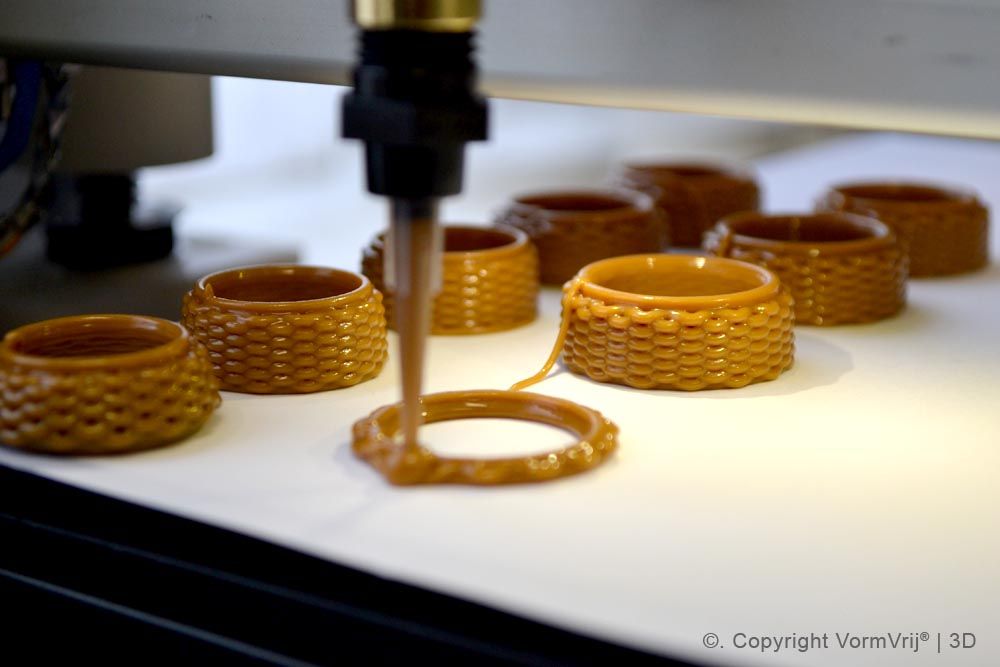 However, prices may decrease in the future, just as they have for regular extrusion (FFF/FDM) 3D printers.
However, prices may decrease in the future, just as they have for regular extrusion (FFF/FDM) 3D printers.
Other promising food 3D printing applications
Here are a few industries where food 3D printing is already beneficial.
Sustainable food
Food 3D printing could be a part of the answer to the world hunger crisis. Indeed, some food 3D printers use hydrocolloids as a consumable.
This chemical, gel-like substance can mimic food. 3D printed meals with hydrocolloids could also include sustainable ingredients, such as algae.
Medical
As explained above, certain food 3D printers use hydrocolloids to create different shapes and textures for meals. Also, like the EU’s PERFORMANCE program is proving, it can be very useful to make softer meals for people with chewing or digestion problems, especially elders.
Also, like the EU’s PERFORMANCE program is proving, it can be very useful to make softer meals for people with chewing or digestion problems, especially elders.
In addition, medicine can be presented in the shape of yummy food, instead of pills or powder.
Army
The US Army is carrying out scientific research to provide personalized food for their soldiers.
According to Lauren Oleksyk, a food technologist leading the team at the Army’s Natick research center, a sensor installed in soldiers’ bodies could detect their specific dietary needs. This sensor would be interfaced with a food 3D printer, to produce customized meals.
Aerospace: NASA food 3D printer
Beehex, an American startup, has received a grant from NASA to develop a food 3D printer.
Indeed, the aerospace agency aims to allow astronauts to produce their own food during long-term space missions to go to Mars!
3D printed food ecosystem
Food ornament 3D printers
Coffee 3D printers: 3D printing on coffee
There seems to be no connection between the portrait of the Mona Lisa and coffee. However, thanks to coffee 3D printers, it is possible to see the beautiful smiling lady in a cup of coffee. Indeed, a combination between 3D printing and inkjet printing technologies allows these machines to draw images on top of any foam-covered beverage.
However, thanks to coffee 3D printers, it is possible to see the beautiful smiling lady in a cup of coffee. Indeed, a combination between 3D printing and inkjet printing technologies allows these machines to draw images on top of any foam-covered beverage.
As such, the Ripple Maker, a coffee 3D printer made by Ripples, can help users print “their own selfies, favorite quotes, or special messages and images on their drinks”. Another existing coffee printer is the Lixian 3D CafeMaker.
Cake ornament 3D printers
Bakery industry professionals also use 3D printers to adorn cakes or pastries. Thanks to edible sheets of paper and ink, any kind of image (including photos) can be 3D printed to decorate cakes.
Food extruders
If users already have an FFF 3D printer at home, another solution exists to 3D print food: food extruders. These tools generally feature universal compatibilities with regular extrusion 3D printers. Some of them, such as the Structur3D Discov3ry, allow 3D print with non-only edible food and clay, silicone, etc. An open-source extruder, the BotBQ Extruder, can 3D print raw meat – a good fit for your future barbecue!
Some of them, such as the Structur3D Discov3ry, allow 3D print with non-only edible food and clay, silicone, etc. An open-source extruder, the BotBQ Extruder, can 3D print raw meat – a good fit for your future barbecue!
3D printed food molds
3D printers can also 3D print very useful tools for food production: this is the case of 3D printed food molds. Users can create their own molds and print them in 3D to customize cakes, for example.
Ripple Maker coffee 3D printer. Credit: Coffee RipplesConclusion
Food 3D printers are suitable for professional, industrial, and personal use-cases. Only paste-type ingredients are printable, but a wide range of food – from pizzas to cakes – can be created. As 3D-printed food can be customized according to users’ needs, it can be helpful in many fields, such as medicine.
3D printed food may also represent a hope for the world hunger crisis in the future.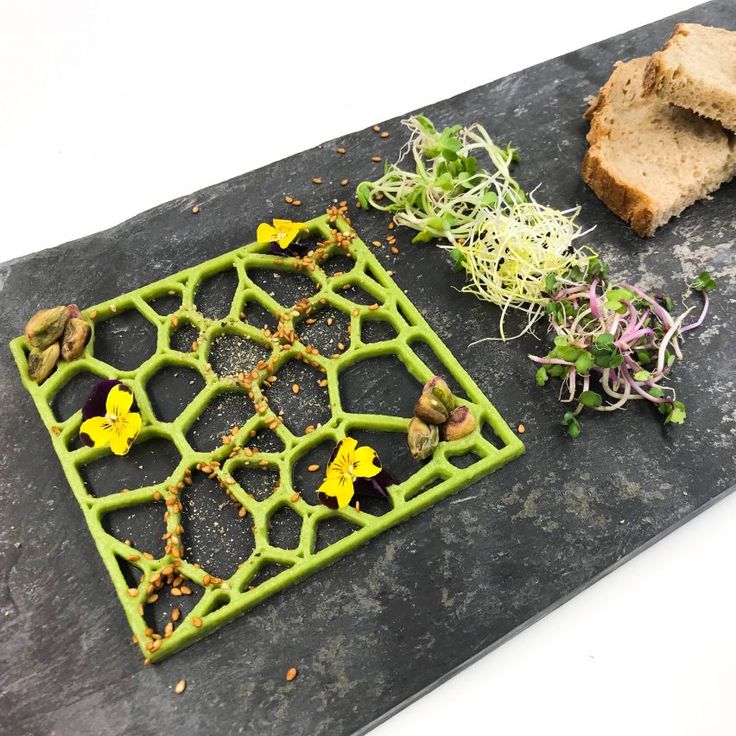 What food 3D printers are still missing is the ability to actually cook or bake. That is why cooking robots could be more and more popular in the future.
What food 3D printers are still missing is the ability to actually cook or bake. That is why cooking robots could be more and more popular in the future.
how 3D food printers can help you maintain a healthy diet April 24, 2018, 23:54
Anastasia Ksenofontova
Scientists from Ewha Women's University (South Korea) have created a 3D printer that prints products with a given nutrient content and predetermined taste properties. On April 24, 2018, the author of the development, Jin-Kyu Lee, presented his invention at the annual meeting of the American Society for Biochemistry and Molecular Biology in San Diego. About the prospect of using "smart" food - in the material RT. nine0003
from 3 d- Products up to 3 D- kitchens
South Korean university of the NIGHA Women's University developed a 3D printer that turns powder ingredients into full-fledged food products with a given content of nutritional substances predetermined taste properties.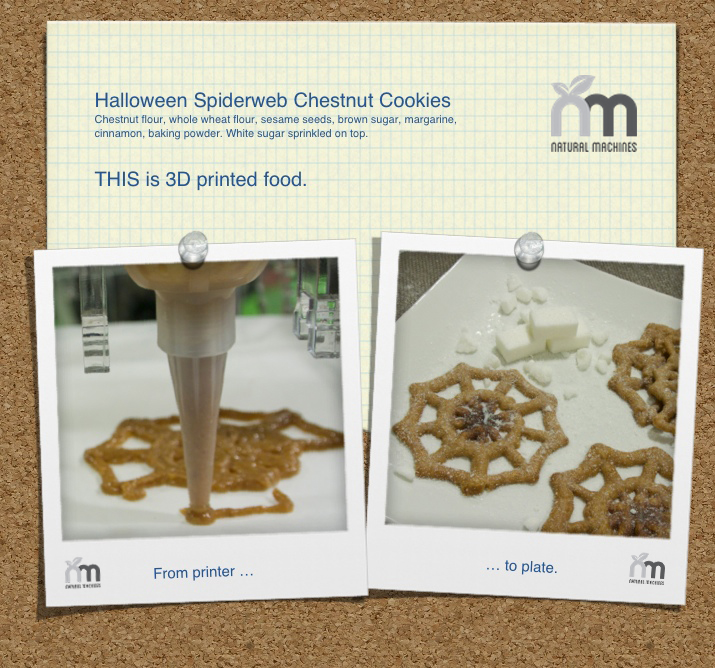
Related
A spoon for the Earth: how a healthy diet can improve the ecology of the planet nine0014
June 2 is Healthy Eating Day. Research scientists show that changing eating habits and accustoming yourself to the right...
Key nutrients (such as carbohydrates and proteins) are ground into powder at a temperature of -100 °C. Then the resulting raw material is heated and turns into a porous film. After that, a three-dimensional product is created from several layers of films. The uniqueness of the development lies in the fact that by combining films with different content of proteins, carbohydrates, trace elements and vitamins, you can get a product saturated with nutrients in the required proportion. In addition, you can experiment with the flavor palette of the product, combining, for example, powdered pear and apple. nine0003
“We believe that one day anyone will be able to purchase cartridges containing powdered analogues of various ingredients that can be “collected” together using 3D printing and prepared a “dish” according to individual needs and preferences,” said the author of the development, the researcher from Ewha Women's University Jin-Kyu Lee.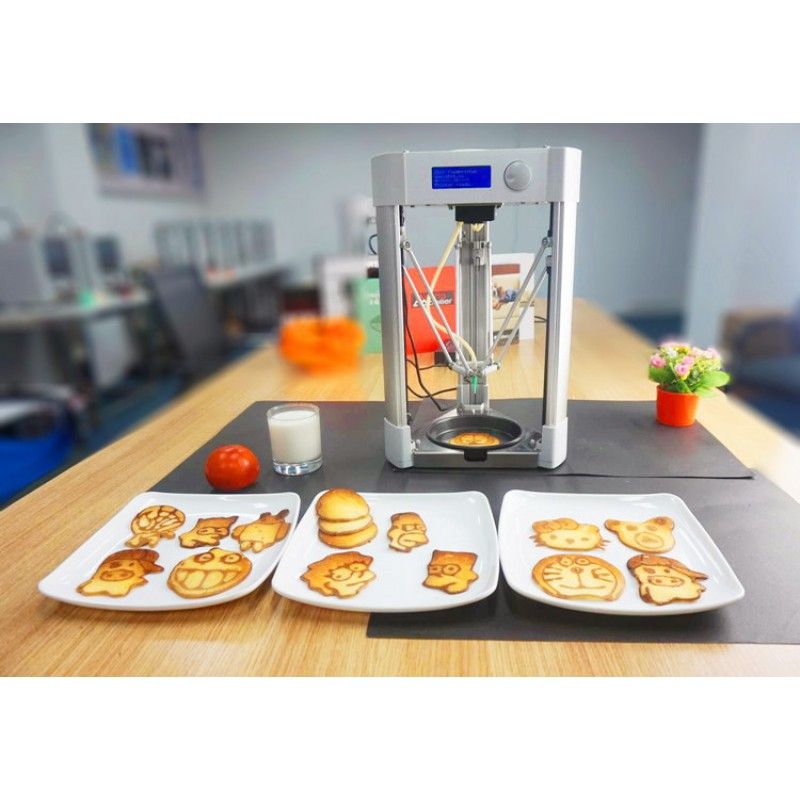
A balanced diet
The developers believe the new technology will significantly reduce the amount of food waste and the financial costs of storing and transporting food. Also, according to scientists, their invention will help meet the food needs of the growing population of the planet. According to the Food and Agriculture Organization of the United Nations, by 2050 the world's population will increase from the current 7.6 billion people to 9.8 billion, and in 2100 it will reach 11.2 billion.
“If a family gets a 3D printer, then they don't have to be afraid of hunger. Of course, we are only at the beginning of the journey. We continue to optimize our development to create customized products that last longer than usual,” said Jin-Kyu Lee.
- © 3D Systems Corporation nine0048
The first 3D food printers appeared in 2015 and could only prepare simple meals. One of these devices works in the FoodInk 3D kitchen restaurant, opened in London in 2016. Everything in this establishment - from food to furniture and cutlery - is created on a 3D printer. The restaurant offers a nine-course menu to visitors. The 3D printer used here works on the principle of a conventional one, the role of ink is played by a paste of edible ingredients, such as cottage cheese or chocolate mousse. nine0003
One of these devices works in the FoodInk 3D kitchen restaurant, opened in London in 2016. Everything in this establishment - from food to furniture and cutlery - is created on a 3D printer. The restaurant offers a nine-course menu to visitors. The 3D printer used here works on the principle of a conventional one, the role of ink is played by a paste of edible ingredients, such as cottage cheese or chocolate mousse. nine0003
According to Russian nutritionists, the development of Korean scientists will help people maintain a balanced diet. However, experts emphasize that it is not worth doing “self-healing” with the help of a 3D printer - first you need to seek advice from a specialist.
“On complex developments that provide for a certain nutrient content, a person will not last long. In addition, it deprives him of the pleasure of eating. Such 3D food can be balanced and healthy, but quickly get bored. And of course, it’s better not to prescribe a diet for yourself, but to turn to a competent nutritionist who will make up a diet based on the state of your body, ”said Alla Pogozheva, professor at the Research Institute of Nutrition of the Russian Academy of Medical Sciences, in an interview with RT.
nine0003
Russian developments
“In Russia, printers for printing products are not yet manufactured. For now, they remain a luxury item. However, in ten years, printers for printing products will most likely become more affordable for the average consumer, ”said Alexander Vinogradov, director of the chemical and biological cluster at ITMO University, in an interview with RT.
Related
"Printed" organ: Chinese scientists have grown and transplanted auricles to five children at once nine0014
Scientists from China have grown new ears for five children born with microtia - insufficient development or complete absence of the ear...
At the same time, 3D printing methods are actively developing in Russia, but in a more fundamental direction. So, domestic researchers from the Federal Research Center "Crystallography and Photonics" of the Russian Academy of Sciences developed in April 2018 the first 3D printer that immediately creates a three-dimensional structure.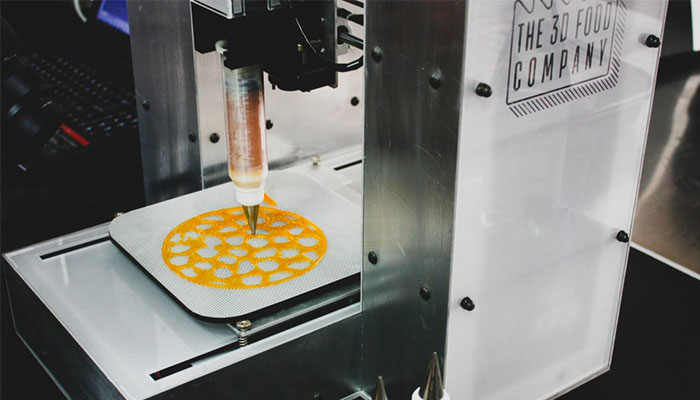 The development of Russian scientists can be used in tissue engineering. The resulting structures made of polymers can replace damaged areas of human tissues and organs. nine0003
The development of Russian scientists can be used in tissue engineering. The resulting structures made of polymers can replace damaged areas of human tissues and organs. nine0003
And scientists from Tomsk Polytechnic University use 3D printing technologies to develop the space industry. They made the first nanosatellite, the body of which is printed on a 3D printer, and they are also creating a printer for work on the ISS, which will help astronauts print the necessary part in the event of a breakdown. In addition, improved technology will make it possible to build bases and stations on the Moon using lunar soil as a material for three-dimensional printing.
characteristics, pros and cons of each model
07.04.2021
Content
-
- What is a food 3D printer
- SPRISTION
- The raw materials used
- Driving 3D printeries
- Popular firms
- Top. : list of the latest models
- 1. PancakeBot 2.
 0
0 - 2. Wiiboox Sweetin
- 3. Choc Creator V2.0 Plus
- 4. Choc Creator V2.0 Plus food 3D printer with cooling chamber
What is a 3D food printer
The main feature of a food 3D printer is the raw materials used: instead of printing ink, the device is filled with edible ingredients. The database stores a large number of different recipes, and in order to print a dish, you just need to select one of them and activate the printing process. The final product is layered on a work surface or on a plate: it can be baked in the oven or sent to the freezer. nine0003
Application
Futuristic 3D Printed Sugar Candy
Cookies printed with glaze
Chocolate logos of famous companies
Cream Photo Print
Buying a food 3D printer is worth the owners of coffee houses, author's bakeries and private workshops.
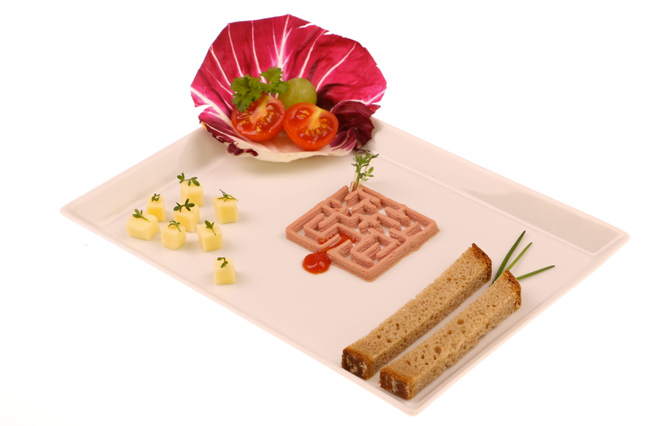 The finished product has a unique shape and bright appearance. Food printers are often used to create custom wedding cakes, cartoon character cookies, Christmas gingerbread cookies, and so on. The possibilities of a baker who owns such a device are endless: the main thing is to buy quality products. nine0003
The finished product has a unique shape and bright appearance. Food printers are often used to create custom wedding cakes, cartoon character cookies, Christmas gingerbread cookies, and so on. The possibilities of a baker who owns such a device are endless: the main thing is to buy quality products. nine0003 Raw materials used
The following ingredients are used as raw materials:
-
Chocolate without additives and impurities;
-
Mastic;
-
Sugar;
-
Whipped cottage cheese;
-
Vegetable and fruit pastes; nine0003
-
Fish and meat pates;
-
Flour;
-
Cheese, etc.
The confectionery pattern is applied to sugar, wafer or shock transfer paper. The first type has a sweetish aftertaste and aroma of vanilla. Due to the snow-white surface, no additional coating is required: the drawings look bright and clear.
 The wafer paper is made from rice flour and does not have a special taste, due to the light shade, the final drawings look less clear. Shock transfer paper is completely transparent and is suitable for transferring a design to a product (for example, a cake). For the packaging of finished products, food-grade plastic for a 3D printer is used. nine0003
The wafer paper is made from rice flour and does not have a special taste, due to the light shade, the final drawings look less clear. Shock transfer paper is completely transparent and is suitable for transferring a design to a product (for example, a cake). For the packaging of finished products, food-grade plastic for a 3D printer is used. nine0003 Interesting! Food printers are involved in waste reduction. Unattractive fruit and confectionery leftovers are used in the preparation of printing mixes. This makes it possible to use the means of production more efficiently.
Types of 3D food printers
Cooking enthusiasts can take advantage of the following food printing devices:
-
Food 3D printers are devices that print dishes whose recipes are listed in a database. The final product is layer-by-layer superimposed on the work surface, and the raw material comes from filled cartridges; nine0003
-
Confectionery printers are used to transfer images onto specialty paper or to design small confectionery products such as candies.
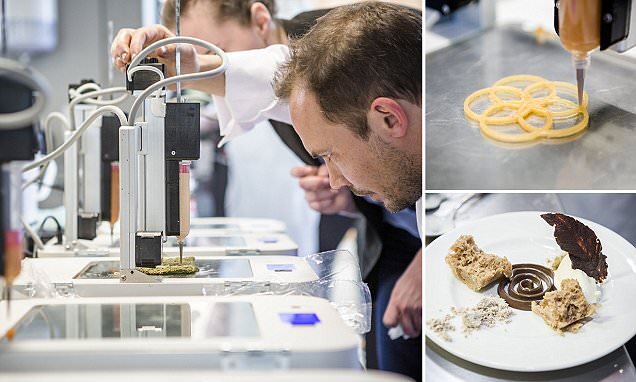 Such printers print an image on pre-prepared paper: rice, wafer or shock transfer;
Such printers print an image on pre-prepared paper: rice, wafer or shock transfer; -
Food plotters transfer the image not to paper, but directly to the finished product. For example, a plotter is used to transfer an image directly onto a cake. nine0003
There are several types of food 3D printers:
-
Extrusion - paint is applied to the surface before the dish is created. The process is controlled by the computer with the loaded image. The system has an extruder that heats the food mixture, and the distribution of raw materials depends on the print head. The raw material is loaded into a syringe placed in the head. This means that in order to combine different shades, you have to periodically stop printing and change the syringe; nine0003
-
A carousel-type food 3D printer also has an extruder, but its main feature is the method of feeding raw materials: the containers rotate around the working surface, the supply and dosage of the material used depends on the recipe specified in the program.
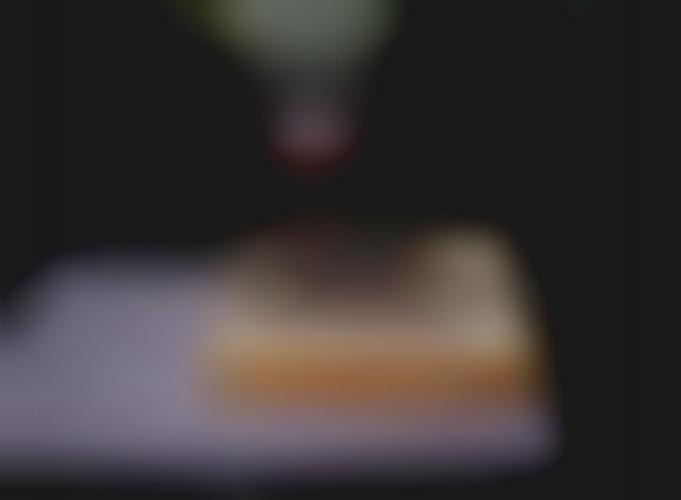 The storage can contain countless recipes, and operation does not cause difficulties even for an inexperienced user.
The storage can contain countless recipes, and operation does not cause difficulties even for an inexperienced user.
Popular manufacturers
Eminent manufacturers offer the best value for money food 3D printer. Quality devices provide accurate printing, high speed, durability, simplicity and ease of use.
Wiibox
This company manufactures 3D printers with high build quality and high productivity. These are universal mechanisms that fill both chocolate paste and mashed potatoes. Numerous positive reviews confirm the high quality of Wiibox products. nine0003
byFlow
The Dutch company byFlow specializes in food printing technology. The pursuit of excellence helps the company open up new horizons: the technique prints products from spinach, meat emulsion and other materials. High build quality, ease of use and durability - all these characteristics are applicable to the products of this company.
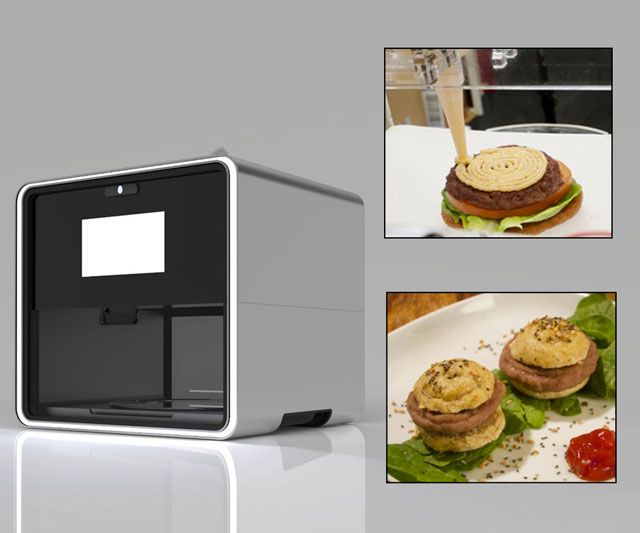
Choc Edge
Choc Edge is committed to revolutionizing the world of chocolate making. Numerous experiments and focus on consumer feedback help to create more powerful devices that provide the optimal temperature for preparing and storing chocolate figures.
Attention! Printing dishes helps save time on cooking: instead of culinary worries, the user can simply activate the printing process and get on with other things.
nine0059Free shipping
Add to compare
Item added to compare Go
Manufacturer Choc Edge Available on credit. To checkout, add the product to the basket and follow the instructions Go nine0003
Manufacturer Wiiboox Free Shipping
Add to compare
Product added to compare Go
Manufacturer Choc Edge Top 10 Best Food Printers: A List of the Most Current Models
Before you buy a food 3D printer, you need to familiarize yourself with the most popular devices on the world market.
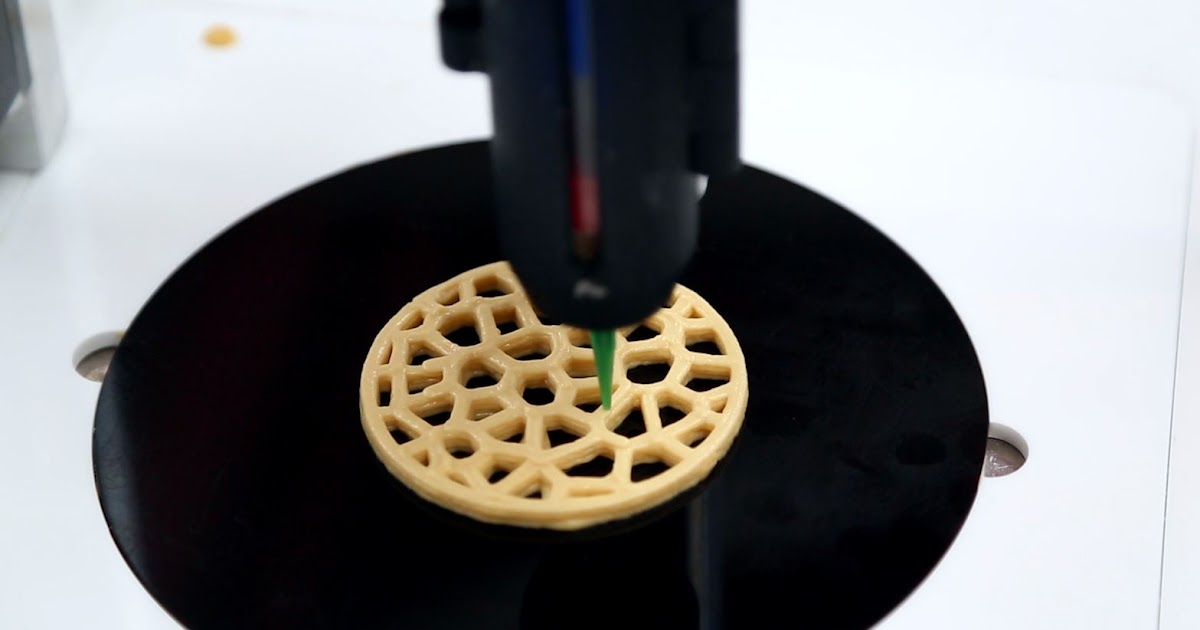 The top is based on ratings and customer reviews. nine0003
The top is based on ratings and customer reviews. nine0003 1. PancakeBot 2.0
PancakeBot 2.0 is easy to use, which means it's suitable for inexperienced users too. Users can choose from suggested designs in the software, or create their own. Used to print pancakes.
Pros:
-
Ease of operation;
-
A wide range of proposed projects; nine0003
-
High speed.
Cons:
2. Wiiboox Sweetin
Buying a food printer from Wiiboox is worth not only for confectionery lovers, but also for ordinary chefs: the device prints cakes, cookies and even mashed potatoes. The main raw materials can be meat, cheese, chocolate, jam, mashed potatoes, dough and much more. A convenient touch panel helps to set the desired mode of operation, and a stylish appearance complements the interior of any establishment. nine0003
Pros:
-
Versatility: the ability to print not only sweet dishes, but also side dishes;
-
Attractive appearance;
-
High build quality;
-
Convenient control by touch panel.
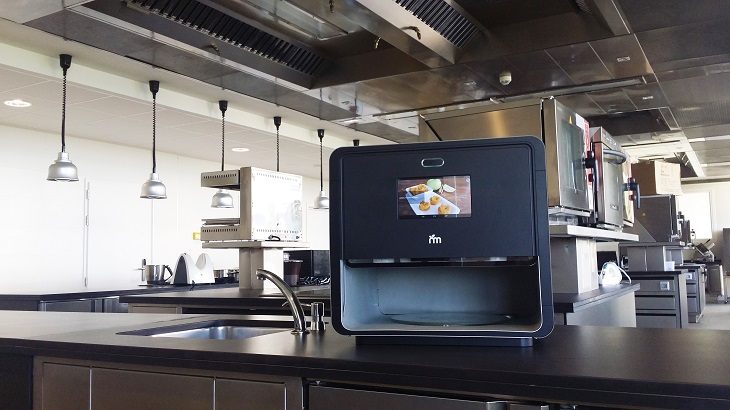
nine0251 Cons:
-
High price.
3. Choc Creator V2.0 Plus
When talking about which chocolate 3D printer to buy, it is worth mentioning the numerous advantages of Choc Creator V2.0 Plus. The new model has become more perfect: the developers have worked hard to eliminate the shortcomings of the previous version. The modern model has small dimensions, so it can be used in any kitchen, and the uniform heating of the syringe ensures high-quality and uninterrupted operation. In practice, the chocolate printer has shown tremendous potential: it prints complex figures from chocolate. nine0003
Pros of :
-
Attractive appearance;
-
Uninterrupted work;
-
Durability;
-
The ability to create durable and beautiful chocolate figures.
Cons :
4.
 Food 3D printer Choc Creator V2.0 Plus with a cooling chamber
Food 3D printer Choc Creator V2.0 Plus with a cooling chamber
The new version of the Choc Creator V2.0 Plus printer is equipped with cooling chambers by popular demand. Users say that maintaining the optimal temperature in the room to preserve the integrity of chocolate figures is too problematic: therefore, the new device cools the raw materials. The price of a food 3D printer with a cooling system is slightly higher than a classic one, but the high performance of the final product justifies any costs. nine0003
Pros of :
-
Availability of a cooling system for finished products;
-
High printing precision;
-
Long service life;
-
Ease of use: You can turn the fans on and off with the side buttons.
Cons :
-
High price.
Attention! Confectionery food 3D printers are often used by artists to create edible masterpieces.
 This is a unique technology that helps to unleash the creative potential of the chef.
This is a unique technology that helps to unleash the creative potential of the chef. 5.byFlow Focus
Food printer from the Dutch company byFlow, which specializes in 3D printing of food. The compact high-tech device is used for the bakery industry, and the cartridges are suitable for the application of any pasty ingredients. nine0003
Pros:
Cons:
6. Chefjet Pro
Buying a ChefJet Pro food printer is a must for people who dream of making bright and stylish sweets. The device is created on the principle of inkjet printing: sugar-containing powder materials are used instead of paints. The final product is made by powder layering. The printer is suitable for combining different shades and creating gradients. nine0003
Pros:
-
The ability to create unique flavors;
-
Neat and bright printing;
-
Aesthetic appearance of the device.
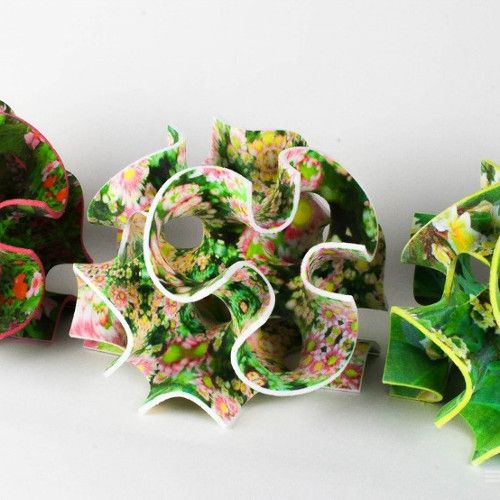
Cons:
-
High price.
nine0051 -
Practicality; nine0003
-
High build quality;
-
Attractive appearance;
-
Availability of an online platform with unique recipes.
-
Ease of operation;
-
High build quality;
-
Affordable cost.
-
High price.

-
In case you want to create realistic images for confectionery 3D printing, pay attention to the diameter of the nozzle: the narrower it is, the more accurate the image will be;
-
It is better for people living in regions with a warm climate to purchase chocolate 3D printers with a cooling system: such devices ensure that the figurines are kept at the optimum temperature;
nine0047
7. Foodini
The 3D food printer from Foodini works on the principle of a stationary printer, but instead of printing inks, layer-by-layer imposition of edible raw materials is used: dough, cream, chocolate, cream, etc. The device is versatile: the user himself can choose the material, or use ready-made cartridges with products.
Pros:
Cons:
8. Mmuse – Chocolate 3D Printer
The closed MMuse 3D printer is suitable for chocolate printing. Chocolate beans are used as raw materials: they are heated in an extruder and fed to the work surface through the print head.
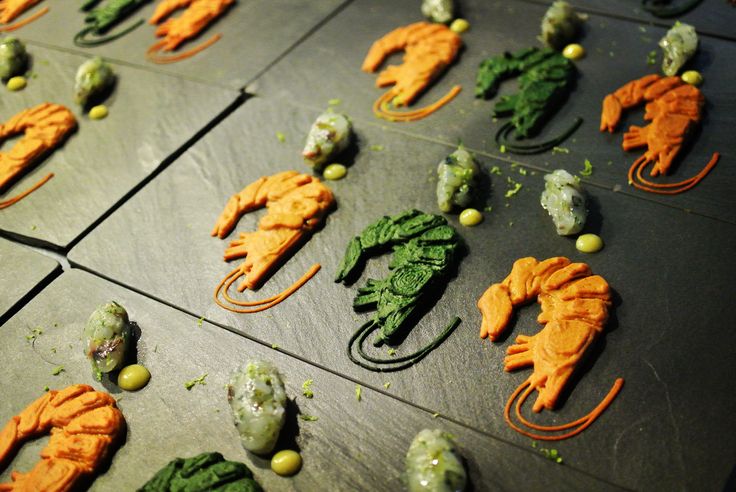 nine0003
nine0003 Pros:
Cons:
9. ZBOT Commercial Art Pancakes Printer F5
ZBOT Commercial Art Pancakes Printer F5 3D Printer
A food printer from Chinese manufacturers is used in the process of making pancakes of various shapes. Ease of operation allows the device to be used by children under adult supervision. nine0003
Pros:
Cons:
10. ZMorph VX
A multifunctional 3D printer capable of printing not only food, but also rubber, ABS plastic, polylactide, PVA, nylon, elastic and metal materials. The product is able to print with chocolate, butter, cookies, icing and other ingredients. In addition, there is a function of engraving and CNC milling. nine0003
Pros:
Cons:
Selection guide
The modern market offers a wide range of food printers. Before you make a purchase, you need to carefully study the characteristics of each model and build on your own preferences. Experts have created several recommendations for choosing: nine0003
The possibility of self-refilling the cartridge is the most practical and economical way to operate the printer;
-
-
Print speed is an important consideration for restaurant owners. Large batches of dishes must be produced quickly, and for home use this is not a very strict selection criterion.
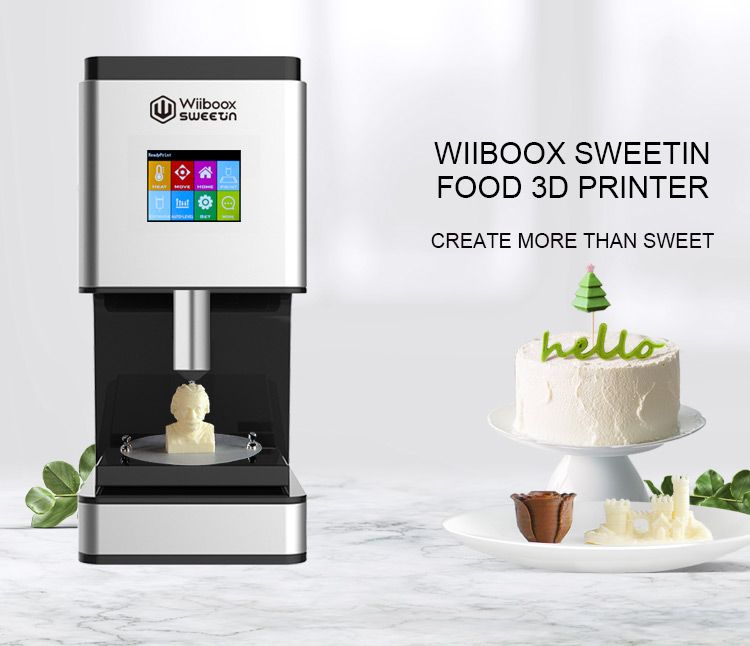
Learn more
- 1. PancakeBot 2.
- What is a food 3D printer


